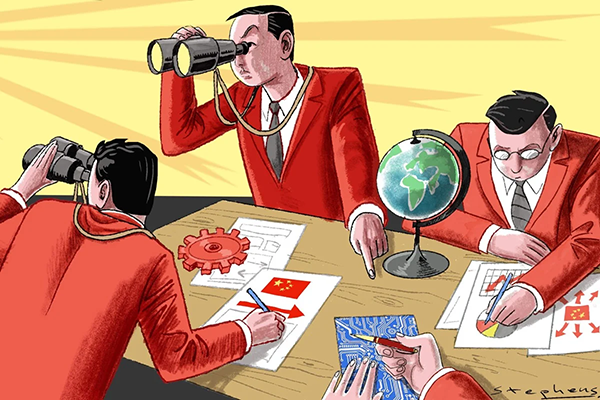Wang Huiyao: Transactional Trump may well improve US-China ties
November 09 , 2024From SCMP, 2024-11-9
■ The new US president is likely to negotiate a second-phase trade deal, seek China’s help to end wars, and keep the Taiwan status quo.
By Wang Huiyao | Founder of the Center for China and Globalization(CCG)
Although Donald Trump’s return as president of the United States brings greater uncertainty, his transactional and pragmatic approach may also provide new possibilities for cooperation and stabilising relations with China. For a start, the president-elect is likely to open new trade and investment negotiations with China.
True, during Trump’s first term from 2017-2021, significant changes took place in the US’ economic and trade relationship with China. In 2017, for the first time, the US national security strategy report positioned China as a strategic rival. Months later, the Trump administration started to slap tariffs on Chinese imports, escalating the trade friction into a trade war. During his election campaign, he also said he was considering tariffs of 10-20 per cent on all imports and 60 per cent or higher on Chinese goods.
But Trump, whose administration negotiated the first phase of the Sino-US trade agreement, may also continue to push for Sino-US economic and trade deals in his second term, including on investment. He may well direct his incoming administration to open new negotiations with China on subsidy policies, overcapacity issues and trade imbalances. He could conduct second- or third-phase trade deal negotiations based on the first.
Also, Trump holds a relatively open attitude towards Chinese business investment in the US and may encourage or require them to invest and set up factories. Fuyao Glass, for instance, has set up factories and taken root in the US while Contemporary Amperex Technology Limited (CATL) is in discussions with American companies about investing in the US.
Trump has close ties with the business community, including many Fortune 500 companies such as Tesla, Blackstone and Apple. These companies have long-term investments in China and this may prompt some rationality in the new Trump administration, which might even lift some limits on Chinese-owned companies such as TikTok, and sanctions on individuals.
Trump will also need to seek Chinese support to resolve the wars he has promised to. Positioning himself as the president for peace, he has claimed he can end the Russia-Ukraine war before his inauguration, even within 24 hours, and threatened to cut military aid to Ukraine if need be. He also reportedly told Israel to end its war before his presidency starts next January.
Trump’s diplomatic thinking is centred on realism, with a stronger transactional style of seeking trade-offs. China is the largest trading partner of Russia and the Gulf Cooperation Council comprising Bahrain, Kuwait, Oman, Qatar, Saudi Arabia and the United Arab Emirates.
It is playing a growing role diplomatically in the Middle East. China not only helped Saudi Arabia and Iran to reconcile but also got the representatives of 14 rival Palestinian factions to sit down in Beijing for unity talks, showcasing Chinese efforts towards peace and a deft use of soft power. China is also Ukraine’s largest trading partner and can play an active role in helping Kyiv rebuild post-war.
When it comes to the Korean peninsula, Trump had previously sought China’s help on the North Korean nuclear issue. If he continues to work with China, the 1953 Korean war armistice could well be upgraded to four-party talks including China and the United States, with the goal of reaching a lasting peace agreement.
Trump, who has repeatedly accused Taiwan of stealing the US’ chip industry, is also likely to take a more pragmatic attitude towards the island, where the pro-independence Democratic Progressive Party won just 40 per cent of the vote in the presidential election. It is possible that China and the US will work to maintain the status quo on Taiwan, to avoid further escalation of tensions and prevent any accidental conflict.
If Trump can keep to the three Sino-US joint communiques, China and the US could even reach a new consensus or agree on a new communique to promote the peaceful reunification of Taiwan and the Chinese mainland.
There are many other possible areas of cooperation. China and the US can jointly address global challenges such as climate change, fentanyl issues, the governance of artificial intelligence and the debt burdens of Global South countries. Such cooperation would benefit not only both countries but also the world.
China can also promote its inbound tourism, establish a visa-free policy for US citizens, increase the number of resident journalists in both countries and expand access to some platforms to foster more open exchanges of culture and other information to reduce tensions and build trust.
Expanding access to platforms such as Google, Facebook and Twitter in China could also foster a more open exchange of information and culture between the two nations. Similarly, the US could consider pulling back from restrictions on platforms such as TikTok.
Sino-US relations have entered a period of structural competition and long-term confrontation. The competition for global influence has gone beyond the scope of short-term policy adjustments and evolved into a strategic game.
The key to the future of Sino-US relations lies in whether the two sides can reach a new consensus on cooperation and coexistence in the midst of their competition, maintain stable bilateral relations and make this stability a priority.
Although Trump’s policies are highly uncertain, his pragmatic and transaction-oriented style may provide a buffer against Sino-US tensions. When he takes office, Beijing and Washington should work to quickly align and list their points of cooperation, and strive to build a stable and predictable framework.
As the two largest economies in the world, China and the US have an obligation to contribute to global peace and development, which is also the hope of the many countries that would rather not have to take sides.
From SCMP, 2024-11-9
Topical News See more






